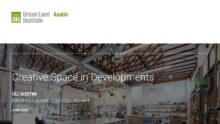On June 14, 2022, ULI Austin’s Creative Culture Strategic Council held a convening of representatives from organizations representing creatives, developers, City of Austin Economic Development staff, and Austin Economic Development Corporation staff and board members. The purpose of this convening was to discuss and identify the opportunities and barriers to incorporating creative spaces within developments. The council opened with a slide presentation outlining why there is a need for creative spaces within Austin, what the various needs are for such spaces, stories of success, current opportunities, and current programs in place. The slide deck is provided with these notes. After the presentation, an open discussion took place for feedback and to help identify barriers to incorporating these creative spaces in developments. Comments are not attributed to allow for free discussion.

DISCUSSION NOTES
- Long permit process, especially when preserving. One project pointed to 39 month process and then only able to preserve 10,000sf of the 17,000sf the developer wanted. Same project identified needing an attorney to get to permitting finish line to be able to start process
- Difficult to reconcile back of house at venues with Great Streets Program because need ability to be able to use the right of way for loading and unloading
- Project Connect has unlocked these conversations beyond downtown
- While W is a success story, more of an exception than a rule in trying to set a precedent
- Right of way permitting has calcified
- Example was given of projects outside of downtown where the owners have helped with artist placement in complexes and now are a vibrant part of the community. Point being that this shouldn’t just be limited to downtown considerations.
- Home Depot was identified as a potential opportunity
- Developers had interest in the 1 to 12 multiplier from the Chicago Theater Study that for every $1 spent in music spaces, $12 are spent in surrounding businesses.
- One developer stated a need to look at retail differently. Creative space can be viewed as a loss leader to be a hospitality or amenity space that drive tenants to activate a building as a whole. This activation allows developers to then charge higher rents – therefore helping cover the cost of that space. Lamar Union was pointed to as an existing example.
- It is scary for the developers to incorporate venues or galleries without an operator identified – who will run it. Need a pipeline to connect with those operators. The AEDC has been brought up as a possible tool for this connection.
- Developers pointed out it is easier to grab on to a known entity (anchor store) than to take a chance. Would be great to connect early with operators
- Gross lease is worth considering as triple nets (NNN) was identified as difficult for all.
- Early identification of space also helps with shared parking, NNN, etc; especially if setting up a condo regime between the creative space and the rest of the development.
- Developers identified that percent profit lease is an interesting tool to start a relationship and help the creative space get started
KEY TAKEAWAYS
- When considering incentives or programs, better not to add difficulties that slow down the development process. Best incentives are to speed up the process.
- Developers need a tool to match up with operators early in project conception. This will provide more security around incorporating the creative space as well as direction for the space needs. AEDC could potentially act as this tool.
- If creating policy for allowances for developments incorporating creative space, consider the needs of those creative spaces (back of house and right of way as examples).
- While many of the developers in attendance are interested in incorporating creative space, they provided feedback that showing the economic return on creative spaces would help with financing and convincing other team leaders. The loss leader to activate the development and the 1:12 study are such examples.
